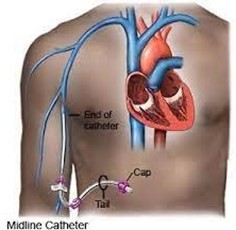The nurse is working on a cardiac unit with several patients who have intravenous access lines. The nurse identifies the following are considered central venous catheters: (Select All That Apply)
Midline catheter
Tunneled catheter
Non-Tunneled catheter
Peripheral IV
PlCC Line
Correct Answer : B,C,E
Explanation: Central venous catheters are catheters that are inserted through a vein in the chest, neck, or groin and then threaded through to a large vein near the heart. These types of catheters are used for long- term treatment and monitoring of critically ill patients.
A midline catheter is a type of peripheral IV catheter that is longer and extends into the upper arm, but it does not reach a central vein and is not considered a central line. Therefore, option a. is incorrect.
A peripheral IV catheter is inserted into a peripheral vein (e.g., hand, arm), and it does not reach a central vein, making it a peripheral line. Therefore, option d. is incorrect.
A tunneled catheter is a type of central venous catheter that is inserted through a small incision in the chest and then tunneled under the skin to a central vein. It is typically used for long-term treatment and is less likely to become infected than a non-tunneled catheter. Therefore, option b. is correct.
A non-tunneled catheter is a type of central venous catheter that is inserted directly into a central vein in the chest, neck, or groin. It is typically used for short-term treatment and is more likely to become infected than a tunneled catheter. Therefore, option c. is correct.
A PICC line (peripherally inserted central catheter) is a type of central venous catheter that is inserted through a vein in the arm and then threaded through to a central vein near the heart. It is typically used for long-term treatment and is less invasive than other types of central lines. Therefore, option e. is correct.

Nursing Test Bank
Naxlex Comprehensive Predictor Exams
Related Questions
Correct Answer is A
Explanation
A. This is the most appropriate response. Clients with COPD often have chronically elevated carbon dioxide levels, which can lead to a compensatory decrease in the oxygen saturation level. A reading of 91% may be within their normal range.
Correct Answer is D
Explanation
This outcome is the most appropriate because smoking can worsen COPD and lead to further respiratory complications, while oxygen is often used to help patients with COPD breathe more easily. Smoking while wearing oxygen can be very dangerous and increases the risk of fire and explosion. Therefore, the best expected outcome is for the patient to completely avoid smoking while wearing oxygen.
Option a is not a recommended solution since vaping may also worsen COPD symptoms and there is limited evidence of its safety in people with respiratory conditions. Option b is a good outcome, but it may not be achievable in such a short time frame. Option c is not an ideal outcome as even a few cigaretes can cause harm to the respiratory system, exacerbate symptoms, and slow down the healing process.
Whether you are a student looking to ace your exams or a practicing nurse seeking to enhance your expertise , our nursing education contents will empower you with the confidence and competence to make a difference in the lives of patients and become a respected leader in the healthcare field.
Visit Naxlex, invest in your future and unlock endless possibilities with our unparalleled nursing education contents today
Report Wrong Answer on the Current Question
Do you disagree with the answer? If yes, what is your expected answer? Explain.
Kindly be descriptive with the issue you are facing.
